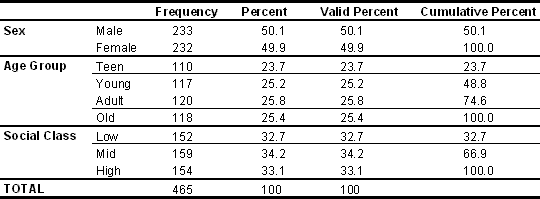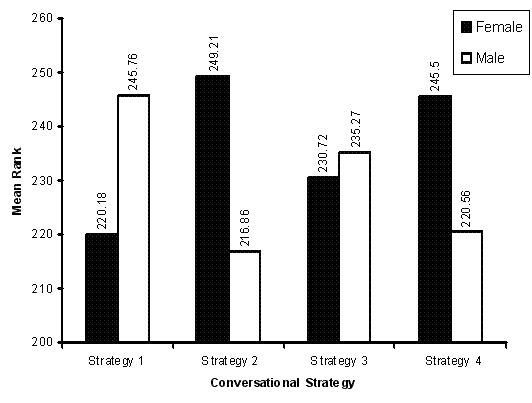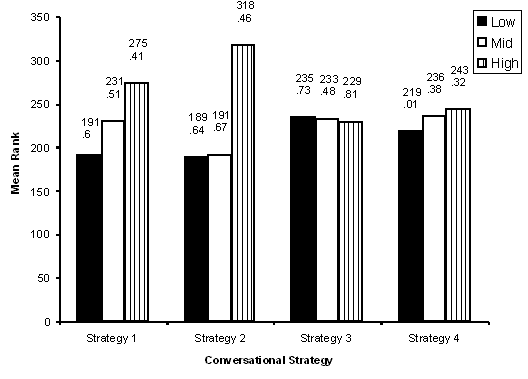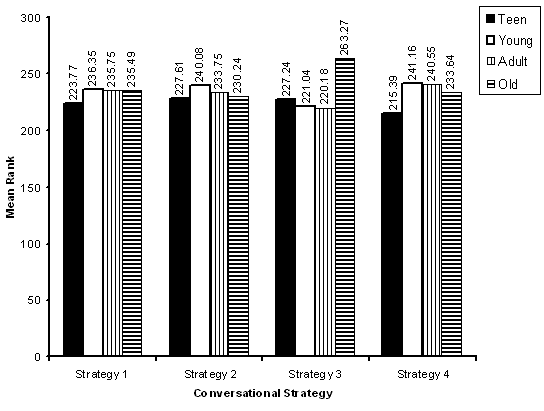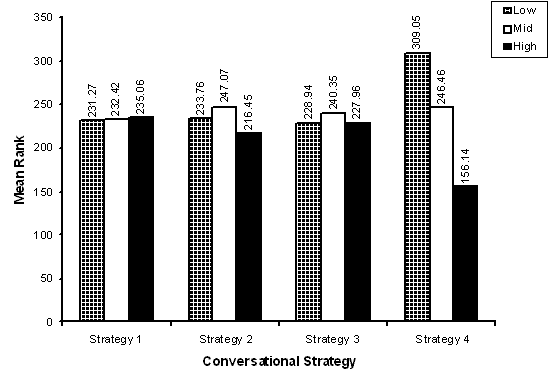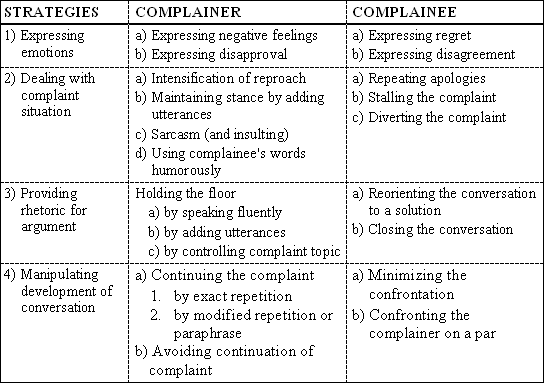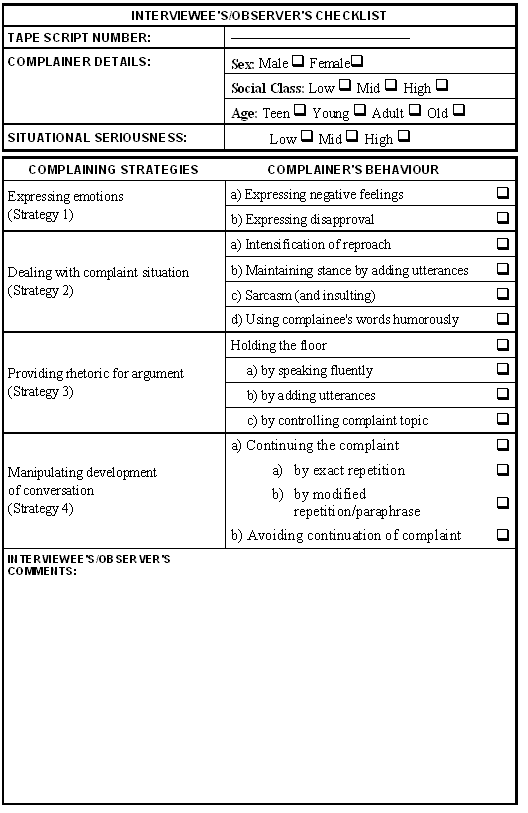|
Mohammad Ali Salmani-Nodoushan (Zanjan/Iran) Conversational Strategies in Farsi Complaints: The Case of Iranian ComplainersIn a study of the effects of complainers' sex, age, perceived situational seriousness, and social class on the use of conversational strategies in their complaining behavior, 465 subjects of varying age, sex, and social class were observed and tape recorded in spontaneous conversation by 25 field workers. The field workers also filled out a checklist that provided the data of the study, which were then input into two nonparametric tests: (a) Mann-Whitney U Test, and (b) Kruskal Wallis H Test. The results of data analysis showed that 'repetition of complaint' was an important strategy in connection to the 'perceived situational seriousness' of the topic of complaint. Sex was found to cause the differential use of three conversational strategies, social class to cause the differential use of two conversational strategies, and perceived situational seriousness and age each to cause that of only on conversational strategy. A cline of significance is suggested for each of the independent variables in question. Suggestions are made for further research. 1 IntroductionDirect complaint (DC) is a face-threatening act through which a speaker makes complaints about someone or something that is present in the speech act scene (Murphy & Neu 1996, Olshtain & Weinbach 1993). Indirect complaint (IC) or Griping, on the other hand, can be described as a non-face-threatening speech act in which the responsible party or object of the complaint is not present during the interaction within which the speech act is performed (D'Amico-Reisner 1985). Both direct and indirect complaints have the potential of leading to lengthy interactions between speaker and addressee; however, it is usually in the indirect complaint or griping that one finds conversational material upon which shared beliefs and attitudes may be expressed (Tatsuki 2000). As such, the indirect complaint (IC) becomes a solidarity-building device since it freely invokes the listener to engage in a series of commiserative responses to demonstrate attention and concern, or to maintain intimacy and stable social relationships. Closely related to the concept of griping is what in Australian English is called whinging. Using Natural Semantic Approach, Wierzbicka (1991: 181f.) defines whinging as:
Wierzbicka (1991) compared her own definition of whinge with the definitions of complaints (direct and indirect) to highlight the range of meanings a word can have with respect to the culture in which it is a part. PhiN 39/2007: 21 According to both Tannen (1990) and Michaud & Warner (1997), indirect complaints frequently serve as back-channels or evaluative responses in an extended structure of discourse exchanges; they may invoke expressions like "Oh, that's horrible!", "Yeah, I know what you mean", and "That's too bad". 2 Review of the related literatureBrown and Levinson's (1978) definition of the notion of face created interest in the study speech acts that had to do with face. One such speech act is complaining. The earliestattempts at studying complaints were made in the 1980s. Jefferson and Lee (1981) and Jefferson (1984a, 1984b) studied 'troubles-telling' encounters from a conversation analysis point of view. Katriel (1985) conducted a research on griping. Katriel examined the ritual gripings among Israelis. All of these studies referred to the potential of establishing solidarity through griping. In a study on Turkish commiserative responses, Bayraktaroglu (1992) found that griping was a common speech act among friends and intimates. He said:
Bayraktaroglu also distinguished griping from troubles-talking in that the latter is a type of oral narrative which is initiated by the former. Indirect complaint (IC) refers to the expression of dissatisfaction to an interlocutor about someone or something that is not present. An indirect complaint is defined as a negative evaluation wherein the addressee is neither held responsible for the perceived offense nor capable of remedying the perceived offense. Native English speakers usually use indirect complaints as a positive strategy for establishing points of commonality; they frequently employ indirect complaints (ICs) in an attempt to establish rapport or solidarity between themselves and their interlocutors. One of the early attempts at studying ICs was made by Boxer (1993a). In boxer's study, 295 interlocutors produced 533 indirect complaints. Boxer identified three different types of IC themes (personal, impersonal, and trivial), and six types of IC responses (nothing or topic switch, question, contradiction, joke/teasing, advice/lecture, and commiseration). The study focused mainly on the role of gender, social status, social distance, and theme in connection to ICs. Since half of interlocutors in Boxer's study were Jewish, it was possible to investigate ethnicity. Boxer found that Jews complain more. She also found that approximately 25% of griping sequences served to distance the interlocutors from one another while 75% of the gripings were found to be rapport-inspiring by a group of ten native English-speaking raters. Boxer's study found that speakers of English often employed gripings in sequential interaction in an attempt to establish solidarity. It was also found that women mostly commiserated with ICs, while men contradicted or gave advice. Boxer noticed that ESL textbooks, with respect to gender, did not include ICs or included them but did not treat them as ICs. The study, therefore, suggested that non-native speakers (NNSs) should know that commiserating with complaints is important in that it signals to the speaker (S) that the hearer (H) is supportive; this builds solidarity. PhiN 39/2007: 22 In another study by Boxer (1993b), indirect complaints as well as commiseration in conversations between Japanese ESL learners and their E1 peers were studied. Boxer used spontaneous speech or field notes. In this study, 295 interlocutors were recorded in spontaneous conversation (195 women and 100 men). The issue that emerged was that of how to respond to an indirect complaint. The results showed that natives used (a) joking/teasing, (b) nonsubstantive reply ("hmn"), (c) question, (d) advice/lecture, (e) contradiction, and (f) commiseration. With NSs most responses were commiseration with some questioning. For NNSs, the major category was nonsubstantive, sometimes accompanied by some questioning and some commiseration. The study concluded that the Japanese ESL learners were missing out on opportunities for conversation by not engaging in the interaction more fully; they did not utilize talk in the same way as NSs did. In a study in 1993 by Frescura, eighty three subjects provided the tape-recorded role-play data on reactions to complaints (mostly apologies). The subjects of the study belonged in four different groups: (a) native Italian speakers in Italy, (b) native English speakers in Canada, (c) Italians residing in Canada, and (d) English-Canadian learners of Italian. The respondents, after being tape-recorded in six role-play interactions, were asked to listen to all six recordings and to provide retrospective verbal report on:
The data were coded according to a taxonomy comprising seven semantic formulas in two categories: (a) hearer-supportive (including formulas providing gratification and support for the "face" of the complainers), and (b) self-supportive (including formulas uttered by the speakers to defend and protect their own "face"). Performance was measured according to the three dimensions of (1) production (total output of formulas, including repetitions), (2) selection (types of formulas used, excluding repetitions), and (3) intensity of formulas produced. The results, after data analysis, revealed that native speakers of Italian had an overall preference for the self-supportive category of formulas; native speakers of English, however, had a preference for the hearer-supportive category. Moreover, Canadian learners of Italian did not indicate any preference; by way of contrast, Italian-Canadian speakers, though diverging some from the native norm, gave indication of language maintenance as well. Frescura had used verbal report which helped her establish, among other things, that the learners of Italian tended to think in English first before responding to the role plays. According to Du (1995), in Chinese culture face is not only socially-oriented but also reciprocal. Some method of maintaining 'face balance' is therefore required. Depending on (a) the relationship between the interlocutors and (b) the nature of the message, the act of 'giving bad news' may in some cases be face-saving. However, 'complaining' and 'disagreeing' are in most cases, clearly face-threatening. The former indicates that the person's behavior is not approved or accepted by other social members and the latter indicates a contradiction or negative evaluation of a person's face. These acts, therefore, require some strategy for preserving the face of both interlocutors. Du (1995) conducted a study with thirty students (male and female) from Beijing Normal University ranging from 19 to 30 years old. The study gave a definition of these three face-threatening acts – complaining, giving bad news, and disagreeing. PhiN 39/2007: 23 Du also discussed the illocutionary verbs which denote these acts and the semantics of face in Chinese culture. Du used a 19-item questionnaire that described face-threatening situations and asked each subject to contemplate the situation and write his or her response. The results of Du's study showed that strategy choice varied according to (a) the referential goal and (b) the nature of the interlocutor relationship. Du also noticed a general pattern: face-threatening acts in Chinese tend to be performed in a cooperative rather than confrontational manner. Attention is paid to both participants face by emphasizing common ground and constructive problem solutions. Morrow (1995) studied twenty students enrolled in two spoken English classes in an intensive ESL program in the United States. Morrow used a three-hour intervention using model dialogues, prescribed speech-act formulae, and various types of performance activities (games and role playing) about refusals and complaints. Oral data were collected in three phases: (a) prior to the intervention, (b) immediately following the intervention, and (c) six months after the intervention. Morrow collected the oral data by means of seven semi-structured role-play tasks which prompted subjects to perform three direct complaints and four refusals with peer interlocutors. The data were analyzed in two ways: (a) using holistic ratings of clarity and politeness, and (b) comparing the pretest and posttest distributions of discourse features with those of native English speaking controls (N=14). T-tests were conducted to compare the pooled pretest and posttest holistic scores. The t-tests, which were significant at p<.0005, revealed improvements in subjects' levels of clarity and politeness; however, similar comparisons of the posttest from phase two of the study, and delayed posttest scores from phase three of the study, did not attain statistical significance. The refusal analysis of discourse features (semantic formulae) revealed increases in the use of politeness strategies, especially of negative politeness strategies. Frequently these developmental changes appeared pragmatically appropriate even when they failed to converge toward the native speaker frequencies. Morrow reported that analysis of propositions and modifiers in the complaint data revealed gains in pragmatic competence. These pragmatic gains were indicated by such changes as (a) increased indirectness, (b) more complete explanations, and (c) fewer explicit statements of dissatisfaction. Morrow's results, which corroborated the findings from the holistic ratings, suggested that speech act instruction helped the subjects to perform complaints and refusals which were clearer, more polite, and, to a limited extent, more native-like. Additional intra-task comparisons found that higher levels of pragmatic competence were achieved when the interlocutor's level of social distance was lower (i.e., friends as opposed to acquaintances). The study conducted by Murphy & Neu (1996) had two objectives: (1) to compare components of the speech act of complaining produced by American native speakers and Korean non-native speakers of English, and (2) to ascertain how this speech act was judged by native speakers based on a number of factors (such as whether the act was aggressive, respectful, credible, appropriate, and similar to what a native would use). As such, the study had two parts: (a) the productive part, and (b) the receptive part. For the productive part of the study, the subjects were fourteen male American and fourteen male Korean graduate students from Penn State University. Twenty-three undergraduate and four graduate students (for a total of twenty seven) participated in the receptive part of the study, who judged the acceptability of the speech acts. PhiN 39/2007: 24 The speech act data were collected by means of an oral discourse completion task (DCT). A hypothetical situation was presented in which the subject was placed in the position of a student whose paper had been unfairly marked and the subjects were directed to "go speak to the professor." Then, the subjects' responses were tape-recorded. The instrument in the acceptability judgment part of the study was a questionnaire with 10 yes-no questions and one open-ended question. Five of the yes-no questions were "distractor items" and the other 5 were designed to measure the native speakers' perceptions about the speech act acceptability. The open-ended question asked, "If you were the student in this situation, would your approach be different from the student you've just heard? Please explain you answer for both speaker-student 1 and speaker-student 2." Each subject was alone during the DCT and his or her data were later transcribed into written form. The speech data elicited for the first part of the study were examined using Cohen and Olshtain's (1981) definition of speech act set. A .05 alpha level of significance was set for a Chi-square analysis of the American students' responses to the five yes-no questions (which were not distractors) and the Yate's Correction for Continuity was used to analyze all differences between responses. Murphy & Neu (1996) found that, when expressing disapproval about a grade received on a paper to a professor, most American native speakers of English would produce a complaint speech act set, while most Korean non-native speakers (11 out of 14) would not; both native and non-native speakers used an "explanation of purpose" to begin the speech act set in similar ways. The native speakers then produced a complaint only after the explanation of purpose. This complaint appeared to be what most of these native speakers felt was the most socially appropriate option for expressing disapproval. The act involved: acceptance of responsibility, depersonalization of the problem, questioning techniques that used modals "would" and/or "could," use of mitigators, and use of the pronoun "we." The 11 non-native speakers who did not use a complaint form employed what was perceived by native speakers as a form of criticism instead which: served to abdicate responsibility, personalized the problem (placed blame), and involved using the modal "should." This represented a serious deviation from the native speakers' speech data. Both the native and non-native speakers then used similar types of "justifications" in their speech act sets, referring to amount of time, effort, and/or work put into the paper. Finally all of the native and most (12 out of 14) of the non-native speakers included a candidate solution: a request form in the speech act set in order to propose an option that would politely remedy the situation (such as reconsidering the grade, discussing the paper, or editing the paper further for an improved grade). As a result of the "criticism" form used by the many of the Korean non-native speakers, native speakers judged the non-native speakers' speech act sets to be more aggressive, less respectful, less credible, and less appropriate than the common "complaint" speech act sets offered by native speakers. In a cross-linguistic study of the speech act of complaining, Nakabachi (1996) compared complaints produced by Japanese L1 speakers and Japanese EFL speakers. The study looked at whether Japanese EFL learners changed their strategies of complaint when they spoke in English, and if so, what factors caused the change. The subjects of the study were thirty nine undergraduate students with an intermediate level of proficiency in English who had no experience of living in English speaking countries. A discourse completion test (DCT) including eight situations was used for data collection. Nakabachi (1996) found that almost half of the subjects changed their speech strategies in English; they used more severe expressions than natives did. This was interpreted as over-accommodation to the target language norms, and seemed to suggest the risk involved with attempting to adapt to the local sociocultural norms. PhiN 39/2007: 25 The study conducted by Arent (1996) is an exploratory research that compares the relative frequency of the performance and avoidance of oral complaints by twenty two Chinese learners and twelve native speakers of American English. The subjects of the study were asked to respond to three problematic situations that were set in the same university housing complex. Three sets of data were obtained: (a) audiotaped roleplays, (b) interview data on perceived situational seriousness, and (c) verbal report data. The respondents were allowed to opt out; in addition, the effects of social distance, power, and type of social contract were controlled for. Arent found that sociopragmatic decision making for Chinese learners and NSs of American English appeared to be associated with (a) individual perceptions of situational seriousness and (b) with culturally-conditioned perceptions of the flexibility of explicit social contracts. Boxer (1996) endorsed ethnographic interviewing as a way of tapping the norms of the communities (a) in research on speech act usage among native speakers in particular languages and (b) in research on non-native speaker pragmatic transfer. She discussed the results of two sets of interviews (one structured and another open-ended) which were designed to evaluate "troubles-telling" in a group of native speakers. Troubles-telling is defined as 'indirect complaining' designed for sharing mutual sentiment between speakers and hearers. Boxer's goal in the studies was to tap not only sociolinguistic knowledge that was explicit, but knowledge that was tacit in the "naive" respondents. There were ten informants who were students, staff, faculty members, or alumni at a large university in the northeastern US, all of Jewish background. The spontaneous speech data consisted of 533 troubles-telling exchanges that were tape recorded or recorded in field notes. Six major categories of responses emerged as ways in which this speech community responded to indirect complaints: (1) response or topic switch, (2) questions, (3) contradiction, (4) joke/teasing, (5) advice/lecture, and (6) agreement/commiseration. Boxer found that troubles-telling in this community was used (a) to further conversation, (b) build relationships, and (c) establish solidarity. She also found that using the same questions with each of the subjects, as was done with the structured interview, was not the best idea because it inherently limited the depth of the subjects' responses. In the second (open-ended) interview, Boxer used a more open format, which allowed for expansion of ideas and greater flexibility of responses. It was easier to obtain more information about the assumptions and perceptions, which shaped the respondents' answers and ideas about troubles sharing. She described the factors that made for a more ideal ethnographic interview, such as (a) rapport with the subjects, (b) having subjects who feel comfortable doing much of the talking, and (c) following the lead of the subjects' narratives. Her findings revealed that in terms of troubles sharing, most respondents felt that while direct complaints qualify as "complaints," indirect complaints were not seen so much as complaining but rather a positive way of sharing mutual information and building relationships. She also found (a) that more women participated in troubles-talk than men and (b) that women were recipients of more indirect complaints because they were seen as more supportive in general than men. Boxer claimed that, while the explicit assumption about complaining was that it constitutes negative speech behavior, tacit assumptions proved otherwise. The subjects of Molloy & Shimura's (2003) study were 304 Japanese university students aged 18–21. They were students at five universities in the Kanto area. To collect the data, a discourse completion instrument (DCT) with twelve complaint situations was used. The DCT was meant to assess EFL complaints. The respondents were allowed to opt out or to give a non-verbal response as well. The respondents tallied two things: (a) the strategies used and (b) the combinations of interactions. Molloy and Shimura found that the two most common strategies were (a) to notify and (b) to seek redress. PhiN 39/2007: 26 Holmes (2003) reports on the Victoria University of Wellington Language in the Workplace (LWP) Project findings regarding talk in the workplace. The corpus had at the time over 2,000 interactions recorded. The focus of the study was on what was necessary for fitting in and becoming an integrated member of the workplace as a community of practice. Holmes' paper examines the positive discourse strategies of small talk and humor; it also illustrates how these provide a challenge for workers with an intellectual disability. Then the analysis turns to the more negatively affective area of workplace whinges and complaints. Holmes specifically examines how whinges and complaints may present difficulties to those from non-English-speaking backgrounds. The study provides a basis for developing useful teaching materials for those entering workplaces for the first time. Drawing on Politeness Theory and the Community of Practice model, Daly, Holmes, Newton, and Stubbe (2004) examined the uses and functions of the expletive 'fuck' in interaction between workers in a New Zealand soap factory work team. They extensively recorded the factory team in their daily interactions to obtain a corpus of thirty five hours of authentic workplace talk from which they selected a small number of paradigmatic interactions for discussion in their paper. Particular attention was given to the way in which the expletive fuck was used in two face threatening speech acts, (a) direct complaints and refusals, and (b) its contrasting function in the speech act of whinging. The analysis focused on the complex socio-pragmatic functions of fuck and its role as an indicator of membership in a specific community of practice. Daly, Holmes, Newton, and Stubbe (2004) demonstrate how the speech act is accomplished over a series of different turns. They illustrated the slippery nature of the concept of politeness, in that they found the expletive fuck to serve as a positive politeness or solidarity marker when confined to members of a particular team within this factory. Kumagai (2004) defined complaint conversations as conversations that involve two parties with distinct communicative orientations: (a) the complainer and (b) the complainee. She distinguished complaint conversations from quarrels in that the former involves an effort by the complainee to minimize the confrontation while, with the latter, the two confront each other on a par. She took the two conversations she used for her study from a corpus she had collected earlier in 1991. In the first conversation the complainer was a male shopkeeper in downtown Tokyo and the complainee a male university student attempting to conduct a survey. The complainer's mother and wife also participated in an effort to keep the peace when the shopkeeper returned to the shop to find the student there after he had told him he could not do his survey there. In the second conversation, one teenage girl was accusing the other of being late for their appointment. Kumagai (2004) focused on these two complaint conversations and discussed how the repetition of utterances within such conversations could function as a conversational strategy to:
In particular she focused on uses of repetition, both exact repetition as well as modified repetition or paraphrase, of utterances made earlier in the same conversation. Kumagai's results supported Tannen's (1990) claim that repetition is a major means for creating speaker involvement and not merely a matter of redundancy. PhiN 39/2007: 27 Molloy & Shimura (2004) looked at responses to complaints in up to twelve situations out of a sample of 259 Japanese university students (80% women). They performed a rigorous statistical analysis and found wide idiosyncratic variation in response patterns. Some respondents were more fine-tuned in their selection of speech acts relevant to the situation in question while others were less so. Molloy and Shimura raised numerous questions as to why this was the case, but they did not provide any preferred explanation. To sum up, the review of the literature related to complaints (whether direct (DC) or indirect (IC), and whether followed by troubles telling or not) revealed three major areas that had previously been studied: (a) functions of complaints, (b) responses to complaints, and (c) conversational strategies used by complainers and complainees for complaining or troubles-telling. According to literature, the functions of complaints are threefold: (a) to further conversation, (b) to build relationships, and (c) to establish solidarity (Boxer, 1993; Boxer 1996). Six responses to complaints have been identified in the literature: (a) no response, nonsubstantive response, or topic switch; (b) questions; (c) contradiction; (d) joke/teasing; (e) advice/lecture; and (f) agreement/commiseration (Boxer, 1993; Boxer, 1996). In addition, there were four conversational strategies which were used by complainers and complainees: (a) expressing emotions, (b) dealing with complaint situation, (c) providing rhetoric for argument, and (d) manipulating conversational development (Kumagai 2004). 3 Aim of the studyThe literature reviewed in the previous section clearly shows the importance of the study of complaints. To date, no study has addressed this speech act in Farsi. As such, the present study was an attempt at describing the salient conversational strategies that are used in the speech act of complaining in Farsi (See Appendix A for a summary of conversational strategies used in complaints). The study specifically focused on the role of complainers' sex, age, perceived situational seriousness, and social class in relation to their complaining behavior. 4 Method4.1 SubjectsA total of 465 subjects (all of them complainers in their spontaneous conversations) comprised the sample of the study. They belonged to different age groups, social classes, and sexes. Table 1 represents the frequency analysis for the subjects of the study. PhiN 39/2007: 28
From the subjects of the study, 233 were male (50.1%) and 232 female (49.9%). As for the age groups, 110 subjects (23.7%) were teenagers (between 13 and 19), 117 subjects (or 25.2%) were young (between 19 and 35), 120 (or 25.8%) were adult (between 35 and 50), and 118 (or 25.4%) were old (50+). 152 of the subjects (32.7%) belonged in the low social class, 159 (34.2%) came from the mid social class, and 154 (33.1%) were members of the high social class. The social class of subjects was identified by such factors, as total monthly income, neighborhood of residence, brand of private car, possession of private cellphones, and possession and type of private house. 4.2 Instruments and proceduresThe data for the present study were collected by 25 field workers who observed and tape-recorded the subjects in spontaneous conversation. The field workers were all master's students majoring in Teaching English as a Foreign Language (TEFL) who had already passed their sociolinguistics and discourse analysis courses. They used hidden tape-recorders to record the spontaneous conversations of the subjects. They were instructed to tell the truth about the recordings to the subjects after they had been recorded, and to ask their permission for using the tape scripts in the study. Those subjects who did not permit the use of their recorded conversations were discarded from the study, and the respective tape scripts were erased. The field workers assigned each tape script a unique reference number and filled out a checklist (one for each tape script) that provided the data for the study (See Appendix B). The field workers also indicated their evaluation of the degree to which they thought the complainers perceived the situation to be serious, and provided any comments that could make the coding of the data easier. The data collected in this way were then submitted to the SPSS 13.0 for Windows (SPSS, Inc., 2004). Three different statistics were used: (a) Frequency analysis, (b) Mann-Whitney U Test, and (c) Kruskal Wallis H Test. Frequency analysis was conducted to identify the proportion and percentage of subjects in the different subgroups of the sample (See table 1 above). The Mann-Whitney U Test (which is the non-parametric counterpart for independent samples t-test) was used to analyze measure the effect of subjects sex on their use of conversational strategies in the speech act of complaining. The Kruskal Wallis H Test (which is the nonparametric alternative to a one-way between-groups ANOVA) was also performed to analyze the effects of subjects' social class, age, and perceived situational seriousness on their use of conversational strategies in the speech act of complaining. PhiN 39/2007: 29 5 Results and discussionThe first question addressed by the study was "Do male and female complainers differ in terms of their use of conversational strategies in their complaints?" To answer this question, the data were analyzed by means of the Mann-Whitney U Test. Table 2 represents the results of the Mann-Whitney U Test for the four conversational strategies commonly used in complaints (See Appendices A and B).
PhiN 39/2007: 30 Mean rank comparisons (figure 1 above) showed that males made use of the first strategy much more than females did. Females, however, made use of the second and fourth strategies much more than their male counterparts did. In other words, males expressed their emotions more openly than females, while females dealt with the complaint situation and provided rhetoric for argument more easily than males. The second question addressed by the study was whether there was a significant difference in the complainers' use of conversational strategies across different social class groups. To answer this question, the data were analyzed by means of a Kruskal Wallis H Test (which is the nonparametric alternative to a one-way between-groups analysis of variance). Table three manifests the results of this analysis.
As it can be concluded from table 2, complainers' social class related to their use of the first and the second conversational strategies in a statistically significant way. The most significant difference, however, related to the second strategy (Chi-Square = 100.037, df = 2, and p = .000). Subjects' social class also affected their use of the first strategy in a statistically significant way (Chi-Square = 40.718, df =2, p = .000).
Low class subjects expressed their emotions less than mid class and high class subjects. High class subjects, on the other hand, expressed more emotions that both mid class and low class subjects. Mid class subjects stood in between. As for dealing with the complaint situation, high class subjects used the strategy much more than both the mid class and the low class subjects. The difference between the mid class and the low class subjects, however, was very small. PhiN 39/2007: 31 Yet another question addressed by the present study was whether there was any statistically significant difference between subjects' use of conversational strategies across different age groups. Here again, a Kruskal Wallis H Test was performed. The results of this analysis are tabulated in table 4 below. In this case, age group was a factor only in relation to the third strategy (i.e., providing rhetoric for the argument). The difference between subjects across different age groups was significant only in relation to complainers' attempts at holding the conversational floor [Chi-Square = 9.272, df = 3, and p = .03 (rounded)]. In connection to the other three strategies, age was not a significant factor.
As is evident from graph 3 below, the only age group that had a mean rank much grater than the other groups in connection to the third strategy was the 'old' age group. That is, subjects within the 50+ age group provided rhetoric for the argument by holding the conversational floor much more than the subjects within the other age groups.
The last question addressed by the present study was whether complainers' perceived situational seriousness affected their use of conversational strategies in any significant way. One again, a Kruskal Wallis H Test was performed. The results of the Kruskal Wallis H Test are presented in table 5 below. PhiN 39/2007: 32
The results of data analysis indicated that perceived situational seriousness was a factor only in relation to the last conversational strategy (i.e., performers' manipulation of the development of conversation). In fact, when complainers thought that the topic of complaint was not that serious, the repeatedly talked about it, either by repeating exactly the same sentences or by paraphrasing their complaints and repeating them (Chi-Square = 109.387, df = 2, and p = .000). As for topics with a high level of perceived situational seriousness, the subjects of the study used fewer repetitions. Topics with a medium level of perceived situational seriousness stood in between. The comparisons of mean ranks for the conversational strategies are illustrated in figure 4 below.
This finding is rather odd. We logically expect more complaint when the topic of complaint is a serious matter, but the subjects of the study behaved in the opposite way. The reason for this discrepancy can be found in the norms that shape the Iranian community. We, Iranians, are culturally brought up in such a way as to avoid conversations that result in clash and conflict. We are repeatedly told by our parents and teachers, from childhood to adolescence and beyond, that conflict and dispute is to be avoided. As such, it is not strange to see that when the topic of complaint is serious, Iranian native speakers of Farsi refrain from continuing their complaints. Serious matters are dispute-prone zones; they readily result in quarrels. Matters with a low level of perceived situational seriousness, however, take some time to result in quarrels. It is not very odd, therefore, to observe that Iranian complainers continue repeating their complaints about non-serious matters, until they realize that the complainee is about to react aggressively, at which time they give in and stop complaining any further. PhiN 39/2007: 33 6 ConclusionBased on the findings of the study, a cline of significance can be suggested for each of the independent variables in question.
Such a cline might look something like the above illustration where the order of strategies (from left to right) identifies the degree to which they are affected the independent variable to the left of them, and where the symbol (?) represents statistical significance. As it is indicated by the cline, sex is the variable that causes the differential use of three conversational strategies whereas social class causes the differential use of only two conversational strategies. Age and perceived situational seriousness cause the differential use of only one strategy; age significantly affects complainers' use of 'providing rhetoric for argument' while perceived situational seriousness significantly affects complainers' manipulation of the development of conversation. The present study only focused on the conversational strategies that were used by Iranian complainers. Similar studies can be designed to research the use of conversational strategies by Iranian complainees. Moreover, similar studies may be designed that address the functions of complaints in Farsi. ReferencesArent, Russell (1996): "Sociopragmatic decisions regarding complaints by Chinese learners and NSs of American English", in: Hong Kong Journal of Applied Linguistics, 1 (1), 125–147. Bayraktaroglu, Arin (1992): "Disagreement in Turkish troubles-talk", in: Text, 12, 317–338. Boxer, Diana (1993a): Complaining and commiserating: A speech act view of solidarity in spoken American English. New York: Peter Lang. Boxer, Diana (1993b): "Complaints as positive strategies: What the learner needs to know", in: TESOL Quarterly, 27 (2), 277–299. Boxer, Diana (1996): "Ethnographic interviewing as a research tool in speech act analysis: The case of complaints", in: Susan M. Gass & Joyce Neu (Ed.): Speech acts across cultures: Challenges to communication in a second language. Berlin: Mouton de Gruyter, 217–239. Brown, Penelope & Stephen C. Levinson (1978): "Universals in language usage: Politeness phenomena", in: Esther N. Goody (Ed.): Questions and politeness: Strategies in social interaction. Cambridge: Cambridge University Press, 56–289. Cohen, Andrew D. & Olshtain, Elite (1981): "Developing a measure of sociocultural competence: The case of apology", in: Language Learning, 31 (1), 113–134. PhiN 39/2007: 34 Daly, Nicola, Janet Holmes, Jonathan Newton & MariaStubbe (2004): "Expletives as solidarity signals in FTAs on the factory floor", in: Journal of Pragmatics, 36 (5), 945–964. D'Amico-Reisner, Lynne (1985): An ethnolinguistic study of disapproval exchanges. Unpublished doctoral dissertation. University of Pennsylvania. Du, Jinwen Steinberg (1995): "Performance of face-threatening acts in Chinese: Complaining, giving bad news, and disagreeing", in: Gabriele Kasper (Ed.): Pragmatics of Chinese as a native and target language. Manoa, Hawai'i: University of Hawai'i Press, 165–206. Frescura, Marinella Anna (1993): A sociolinguistic comparison of "reactions to complaints": Italian L1 vs. English L1, Italian L2, and Italian as a community language. Unpublished doctoral dissertation. University of Toronto, Toronto. Holmes, Janet (2003): "Talk at work and "fitting in": A socio-pragmatic perspective on workplace culture", in: Gillian Wigglesworth (Ed.): Marking our difference: Languages in Australia and New Zealand universities. Proceedings of Conference on Language Education in Australian and New Zealand Universities. Melbourne: University of Melbourne, 95–115. Jefferson, Gail (1984a): "On step-wise transition from talk about a trouble to inappropriately near-positioned matters", in: J. Maxwell Atkinson & John Heritage (Ed.): Structures of social action: Studies in conversational analysis. Cambridge: Cambridge University Press, 191–222. Jefferson, Gail (1984b): "Laughter organization in talk about troubles", in: J. Maxwell Atkinson & John Heritage (Ed.): Structures of social action: Studies in conversational analysis. Cambridge: Cambridge University Press, 346–369. Jefferson, Gail & John R. E. Lee (1981): "The rejection of advice: Managing the problematic convergence of a "troubles-telling" and a 'service encounter'", in: Journal of Pragmatics, 5, 399–422. Katriel, Tamar (1985): "'Griping' as a verbal ritual in some Israeli discourse", in: Dialogue, 367–381. Kumagai, Tomoko (2004): "The role of repetition in complaint conversations", in: Polly Szatrowski (Ed.): Hidden and open conflict in Japanese conversational interaction. Tokyo: Kurosio, 199–220. Michaud, Shari L. & Rebecca M. Warner (1997): "Gender differences in self-reported response to troubles talk", in: Sex Roles 37 (7–8), 527– 540. Molloy, H. P. L. & Mika Shimura (2003): Approaches to a theory of complaint interactions. Paper presented at the JACET 42nd Annual Convention, Sendai, Japan, September 5, 2003. Molloy, H. P. L. & Mika Shimura (2004): An examination of situational sensitivity in medium-scale interlanguage pragmatics research. Temple University, Tokyo, Japan. Morrow, C. K. (1995): The pragmatic effects of instruction on ESL learners' production of complaint and refusal speech acts. Unpublished doctoral dissertation, University of New York at Buffalo, Amherst, NY. [UMI Microform, UMI Number: 9603629] PhiN 39/2007: 35 Murphy, Beth & Joyce Neu (1996): "My grade's too low: The speech act set of complaining", in: Susan M. Gass & Joyce Neu (Ed.): Speech acts across cultures: Challenges to communication in second language. Berlin: Mouton de Gruyer, 191–216. Nakabachi, Keiichi (1996): "Pragmatic transfer in complaints: Strategies of complaining in English and Japanese by Japanese EFL speakers", in: JACET Bulletin, 27, 127–142. Olshtain, Elite & Liora Weinbach (1993): "Interlanguage features of the speech act of complaining", in: Gabriele Kasper & Shoshana Blum-Kulka (Ed.): Interlanguage pragmatics. Oxford: Oxford University Press, 108–122. SPSS Incorporation (2004). SPSS 13.0 for Windows [Computer Software]. Chicago, IL.: SPSS Incorporation (1 September 2004). Tannen, Deborah (1990): You just don't understand: Men and women in conversation. New York: William Morrow & Company. Tatsuki, Donna Hurst (2000): "If my complaints could passions move: An interlanguage study of aggression", in: Journal of Pragmatics, 32, 1003–1017. Wierzbicka, Anna (1991): Cross-cultural pragmatics: The semantics of human interaction. Berlin: Mouton de Gruyter. (= Trends in linguistics, Studies and monographs, 53) PhiN 39/2007: 36 Appendix A: Summary of Conversational Strategies Used in Complaints
PhiN 39/2007: 37 Appendix B: Checklist to be filled out by the observer/interviewee
|
